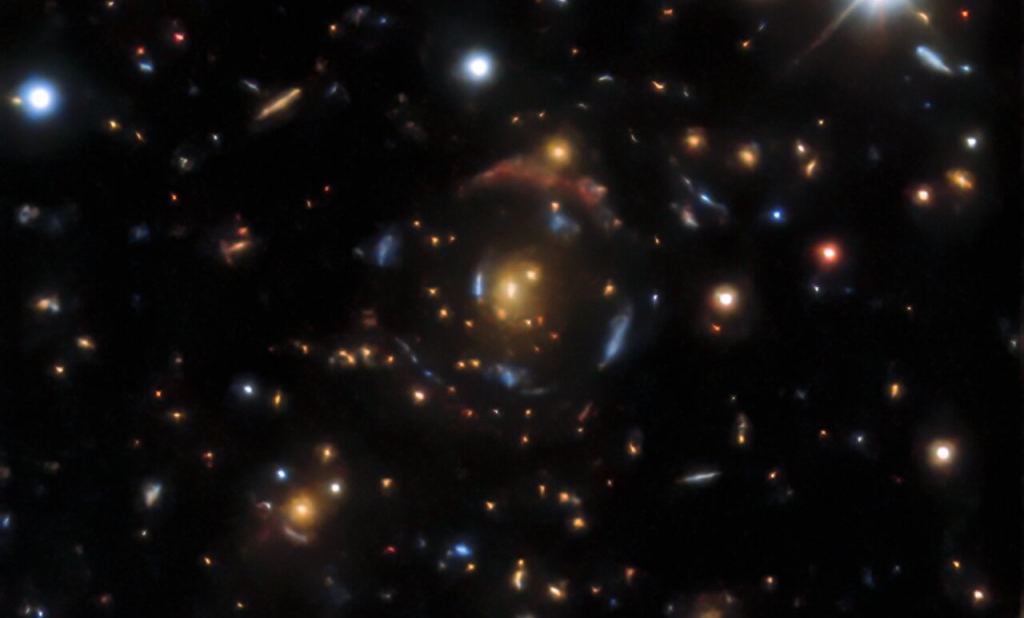Dark Energy Survey Finds Hundreds of New Gravitational Lenses
By Andy Tomaswick
It’s relatively rare for a magical object from fantasy stories to have a analog in real life. A truly functional crystal ball (or palantir) would be useful for everything from military operations to checking up on grandma. While nothing exists to be able to observe the mundanities of everyday life, there is something equivalent for extraordinarily far away galaxies: gravitational lenses. Now a team led by Xiaosheng Huang from Lawrence Berkeley National Laboratory (LBNL) and several universities around the world have published a list of more than 1200 new gravitational lensing candidates.
Gravitational lenses occur when a massive object, such as a galaxy, is aligned directly between Earth and another massive object even farther away. Although normally attributed to Einstein, they were first published by Orest Khvolson and Frantisek Link in 1924 and 1936 respectively, and result from the general theory of relativity. This theory posits that light from the source (i.e. the farther away object) will bend around the gravitational weight of the object in the foreground.

Credit: NASA
The effects of this bending can be mesmerizing, such as the Molten Ring we reported on late last year. However, so far, there have been only a few hundred examples of such light distortion found in the universe. A finding of 1,200 new potential candidates is a huge boost to the total catalogue of these fascinating phenomena, potentially doubling the number ever found.
The reason they are “candidates” rather than confirmed lenses is in part because the work to discover them was done by a computer-generated algorithm. Researchers developed a neural-network based algorithm originally developed for the Strong Gravitational Lens Finding Challenge. Data from the Dark Energy Camera Legacy Survey (DECaLS) was fed into the winning algorithm to result in the new catalogue.
As any computer scientist will tell you, training sets are one of the most important inputs to a neural-network program. Students chipped in on this important aspect, with undergraduates helping to sort through tens of thousands of images, eventually coming up with 632 previously discovered lenses and 21,000 non-lens images, to make sure the algorithm could differentiate between real and imitational lenses.
This painstaking work and algorithm collaboration contained 60 “Grade A” lenses, which are those with the most pronounced lens-like features. An additional 105 “Grade B” (slightly less pronounced) and 176 “Grade C” (fainter features) candidates round out the total. To prove that these candidates are in fact gravitational lenses, the team secured observing time on the Hubble Space Telescope, which began back in 2019.

Credit: DESI Legacy Imaging Surveys, Berkeley Lab, DOE, KPNO, CTIO, NOIRLab, NSF, AURA)
Their final results with the Hubble data have yet to be published. But the LBNL researchers aren’t the only ones using this technique to search for gravitational lenses. A team from Australia released another list of potential lenses not, and the LBNL team only found about 60% of what that team did. The rest was likely up to differences in training sets or algorithmic quirks. Obviously there is still a lot more to discover in the world of gravitational lenses.
If the researchers could use a crystal ball to find all of them, that would make their task much easier. However, they are limited to Earthly technology, such as the Vera C Rubin Observatory, which is getting ready to launch in 2023. With the additional observing power of these new platforms, the team hopes to get to 1,000 new lensing candidates, dramatically increasing the total number of those phenomena found so far. A true crystal ball would probably also be able to tell you if they’ll be able to or not.
Learn More:
LBNL: AI Finds more than 1,200 Gravitational Lensing Candidates
LBNL: Seeing the Universe Through New Lenses
arXiv: Discovering New Strong Gravitational Lenses in the DESI Legacy Imaging Surveys
NOIR Lab: Doubling the Number of Known Gravitational Lenses
Lead Image:
Gravitational lenses compared side-by-side with the DECaLS survey and Hubble’s image of them.
Credit: Dark Energy Camera Legacy Survey, Hubble Space Telescope
The post Dark Energy Survey Finds Hundreds of New Gravitational Lenses appeared first on Universe Today.

February 5, 2021 at 08:51AM
via Universe Today read more...

Post a Comment